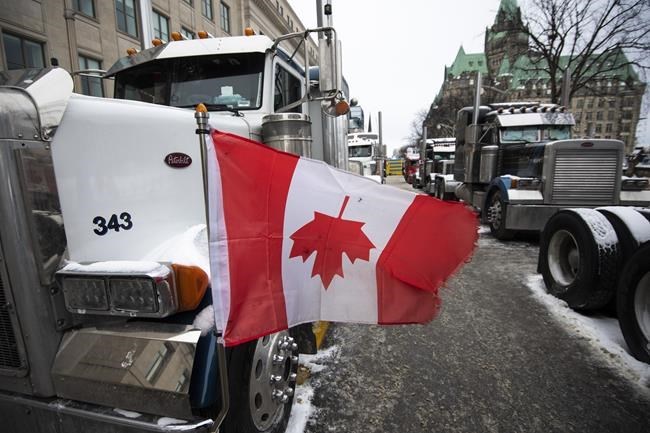VANCOUVER — The symbolism attached to national flags often revolves around patriotism, but experts say the Maple Leaf’s prominent appearance at COVID-19 mandate protests comes at a moment of reflection for Canada.
Canadians might not be known as fervent flag wavers like their U.S. neighbours, but the Maple Leaf’s display at protests on Parliament Hill and at border crossings has given some people pause, said Carmen Celestini, a post-doctoral fellow with the Disinformation Project at Simon Fraser University's school of communication in Burnaby, B.C.
"It's definitely jarring for everybody and making people really think about who we are as a nation on so many different levels," she said in an interview.
Images of the flag fluttering from trucks, flying upside down or worn as a cape have captured attention since the blockade began in Ottawa on Jan. 28.
Celestini said most Canadians are having a moment of reflection when it comes to the flag, which began with the discovery of what are believed to be 215 unmarked graves at a former residential school in Kamloops, B.C. The announcement led some cities to cancel Canada Day events in a national reckoning of the country's colonial past.
The flag symbolizes freedom for the truckers, she noted.
"The word freedom can mean so many different things to so many different people," she said. "That is a really good word for social mobilization."
In the 57 years since it was first raised, the Maple Leaf has been hoisted by Olympic athletes in victory, wrapped around coffins of soldiers coming home from Afghanistan in an image of mourning, lit on fire at protests, and worn on hats and sewn on backpacks of travellers.
In Ottawa, it has been fastened to the front of vehicles, sometimes with slogans scrawled across it, becoming an emblem of political affiliation for some.
Phil Triadafilopoulos, an associate professor of political science at the University of Toronto, said most of the flags being flown at the protests in Ottawa are the Maple Leaf although there are a few others.
"So, you know, what does that say about this sort of political orientation of the people assembled there?" he asked.
"I guess the vast majority of them think of themselves as Canadian patriots of some kind."
It's safe to say, he said, that those on the left of the political spectrum don't typically make the same outward expressions of national identification as those on the right.
John Vile, a professor of political science and a dean at Middle Tennessee State University, said the flag is not “quite an empty vessel” as a symbol in the United States and other nations.
"Many people pour their ideas of what they consider to be the most basic and noble aspirations into the symbol, including liberty," he said.
While a flag is meant as a symbol of national unity, Vile said it appears to be used more by the right than the left at this time in U.S. history. This may partly be a result of athletes and others who have "taken a knee" during playing of the U.S. national anthem as they question whether the flag has lived up to American ideals of freedom and equality for all, especially people of colour, he said.
But U.S. politicians of all stripes have long sought to wrap themselves and their policies in the American flag, he added.
"I think it would be tragic if it came to be viewed as a purely partisan symbol," he said.
Celestini said some of that symbolism has seeped into Canada from the United States.
It's reflected in the language and slogans used in Ottawa including "Make Canada Great Again" and calls for Prime Minister Justin Trudeau to be tried for treason.
"It's very much the language that was articulated in the south during the last couple of elections," she said.
Vile said the flags of all countries are inextricably bound to the idea of nationalism, and love of country isn't confined to one party.
"I don't think liberals love the country any less than conservatives do," he said.
Celestini agreed, adding that the flag cannot be taken over by any one group.
"It is a nation's flag. The flag is definitely individual and definitely national."
Triadafilopoulos said Canada is not as intense as the United States when it comes to flag-waving but there is a sense of pride in its display.
He said he finds it disrespectful when the flag is flown upside down and worries that a shared symbol is being appropriated by some to advance a narrow agenda.
"But I also know that the Canadian flag is important for many Canadians and will likely continue to serve as a common symbol that unites more than it divides," Triadafilopoulos said.
"It's one of those few things that Canadians of all stripes feel quite comfortable with and close to."
This report by The Canadian Press was first published Feb. 17, 2022.
Hina Alam, The Canadian Press




